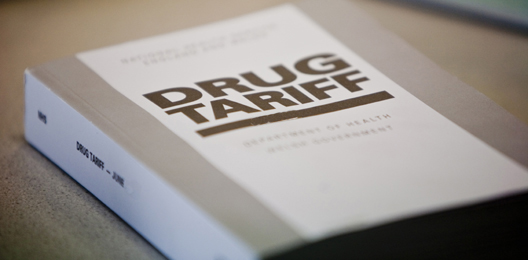Prescription switching
Published on: 23rd July 2013 | Updated on: 21st November 2022
Download our factsheet: Prescription Switching.
QUICK LINKS |
| REF: Drug Tariff Part XVI |
| EPS exemption |
| Exemptions from charge |
| Prescription Charge Refunds |
During the pricing of prescriptions, if the Pricing Authority does not agree with the charge group (i.e. paid or exempt) in which a prescription has been submitted, the prescription will be ‘switched’.
Exempt Forms
For forms submitted as exempt: if a declaration of exemption is required on the reverse of the form, but has not been completed correctly, the form is ‘switched’ to chargeable and a prescription charge is deducted from a contractor’s payment for each item on that form.
Chargeable Forms
For forms submitted as chargeable: if there is found to be a completed declaration of exemption or the patient is age exempt with a computer generated date of birth or age on the prescription, the form is ‘switched’ to exempt and charges are not deducted for the items on that form.
Prescription forms are no longer automatically switched from ‘exempt’ status to ‘chargeable’ by the Pricing Authority. Any form that is identified as a potential candidate for switching is now referred to an operator to assess the prescription and make the final decision over whether the prescription should be ‘switched’.
Why does switching occur?
Prescription switches generally occur at the Pricing Authority for two main reasons:
- The declaration on the reverse of an exempt prescription has not been completed correctly by the patient.*
- A paid prescription has been incorrectly filed with exempt prescriptions by the pharmacy before submission.
These prescriptions will be switched from ‘exempt’ to ‘paid’ by the Pricing Authority and prescription charges will be deducted for each item.
*The declaration on the reverse of a prescription form must be completed on all occasions except where:
- the patient is aged under 16, or 60 or over and a computer-generated date of birth is printed on the prescription
- it is a prescription for a prisoner on release where the practice address box on the front of the form includes the printed letters ‘HMP’ along with the issuing prison address and local NHS England teams allocated number
- the prescription is a ‘Bulk’ Prescription (i.e. an order for two or more patients bearing the name of a school or institution in which at least 20 persons normally reside. See Drug Tariff Part VIIIA, Note 9)
The Department of Health and Social Care will not grant any further concessions for a contractor’s failure to ensure exemption declarations are completed where required; therefore it is essential that all contractors review their prescription receipt and processing procedures, ensuring that patient declarations are completed correctly and that all prescriptions have been filed in the correct charge group before submission to the Pricing Authority.
TOP TIPS: How to Prevent Prescriptions from Being Switched
Prescription switching statistics can be found on page 2 of your FP34 Schedule of Payments. It details the number of switches made by the Pricing Authority and the reasons why. It is important to monitor this closely, for example to ensure that the Pharmacy Team are following prescription receipt SOPs and ensuring exemption declarations are completed correctly, where required. |
EPS exemption status to be entered onto each electronic prescription
In addition to the current endorsing information, pharmacy staff will also have to mark whether a prescription charge was levied for a prescription, and where relevant the prescription charge exemption category and whether evidence of exemption was seen. The exception to this is where the patient is age exempt and the patient’s date of birth is included in the electronic prescription message.
Pharmacy system suppliers have flexibility in the way they support pharmacists in entering this information, for example if pharmacy staff have already recorded the details of a valid exemption certificate, for example a pre-payment certificate, the system could be set to pre-populate this information on the system – the pharmacy would still be required to collect the patients exemption declaration on the prescription or dispensing token where required.
See more at EPS exemption
Incorrect Switching by the Pricing Authority
Incorrect prescription ‘switching’ by the Pricing Authority has historically been a problem for some pharmacies submitting prescriptions for reimbursement. The majority of incorrect switching occurred where the automated payment (or CIP) system’s intelligent character recognition software suspected that a prescription should be ‘switched’ and then automatically changed the prescription charge status from exempt to chargeable; deducting the relevant number of charges from the contractor’s account.
As affected forms are no longer automatically switched but are referred to an operator to be manually switched, this has led to a considerable decrease in incorrectly switched forms since 2011.
The Pricing Authority have introduced a number of additional measures to minimise the risk of switching errors including:
- identifying and incorporating best practice procedures within the batch preparation process to ensure prescription forms are scanned in the appropriate groups;
- carrying out refresher training with those operators involved in confirming the group in which forms should be submitted;
- introducing system changes to make the process as clear as possible for operators.
Monitoring Switching Accuracy
To monitor on-going accuracy of prescription pricing, Community Pharmacy England undertakes routine audits of contractors’ prescription bundles and this also includes monitoring of switching. For more information on Community Pharmacy England’s auditing of prescriptions, please visit this webpage.
Community Pharmacy England finds that although the switching was correct in the majority of bundles reviewed, on a rare occasion, prescriptions can be switched incorrectly and this information is fed to the Pricing Authority so that adjustments can be made to the individual contractor accounts concerned.
Through our audit work, it is actually more common to find prescriptions that should have been switched during processing but have not been and this can result in a charge being deducted from the contractor’s account for every item on the form. Following the tips above will help prevent this from occurring.
FAQs
In this scenario the prescription should be placed in the ‘chargeable’ group.
The item itself will be switched to give it an ‘exempt’ status, but it will not be shown on the Schedule of Payments as a switch as the Pricing Authority does not deduct charges where the prescribed item is a contraceptive medicine or device included in the Drug Tariff list of products to be supplied to patients free of charge.
The Pricing Authority will return switched forms to a pharmacy contractor on one single occasion only for training purposes. Any subsequent requests should be directed to your local NHS England teams in accordance with Direction 7 of the Pharmaceutical and Local Pharmaceutical Services (Prescriptions, Payments and Listings) Directions 2013. Local NHS England teams are required to provide pharmacy contractors with reasonable facilities for examining all or any of their prescription forms, together with details of the amount calculated by the Pricing Authority as payable.
To arrange to view forms, contractors should make a request to their local NHS England teams (including details of the forms concerned, e.g. a particular prescription month). The local NHS England teams will then request the forms from the Pricing Authority.
No, there is no requirement for the exemption declaration to be completed using a pen with a particular ink colour. All forms are reviewed by an exception handler before a prescription is considered for switching therefore, even if the CIP scanner cannot read the signature due to ink colour, the handler will be able to.
This issue is governed by the “Law of Agency”. This states that a representative, in this case the pharmacy, acts as if they are an extension of the patient. Consequently any liabilities or penalties incurred by acting as an “agent” are in fact liabilities of the patient. This is because the patient is the original source of information which is provided to the pharmacy and the ultimate beneficiary of a free prescription. Therefore, if the information is incorrect the patient will be liable, not the pharmacy.
In order to act as agent for the patient, the pharmacist would need to be sure that the patient understands that he had asked him to sign as his agent, to create the agency relationship.
The advice from the Counter Fraud and Security Management Service (now known as NHS Protect) is that generally, pharmacists should not sign as the patient’s representative as they are financially involved in the transaction and would also be responsible for establishing that the patient is exempt from prescription charges.
Unfortunately, Community Pharmacy England has been informed of cases where pharmacists or other members of the Pharmacy Team have erroneously signed prescriptions on behalf of patients, where the patient was not present in the pharmacy at the time of dispensing, and then these patients have received letters from the NHS seeking repayment where it has transpired that the patient was not actually entitled to exemption from charges. The signing of the exemption claim is therefore not recommended, unless the pharmacist or the Pharmacy Team see the proof of entitlement to exemption.
Please note, the use of a pharmacy stamp instead of a signature in part 3 of the patient declaration is not accepted, the prescription must be signed by the patient/ a representative.
The National Health Service (Charges for Drugs and Appliances) Regulations 2000 as amended requires a pharmacy (and other NHS suppliers ) to collect the prescription charge unless there is a valid claim for exemption (other than the exceptions, such as for oral contraceptives, or the age-related exemptions where the date of birth is printed on the form).
Under Regulation 3(7) of those Regulations, any sum payable by the local NHS England teams to the Chemist (i.e. reimbursement and remuneration to the pharmacy) shall be reduced by the amount of charges which are required to be made. This requirement to deduct the amount equivalent to the charges for all chargeable prescriptions is mandatory, and therefore the Pricing Authority not only has lawful authority to deduct the charges, but is required by the Regulations to do so.
Related resources
Payment Factsheet 2 – Prescription Switching
Dispensing Factsheet: Exemptions from the prescription charge
Exemptions from the Prescription Charge
Number of items – getting your declaration right
How are Your Prescriptions Processed?












